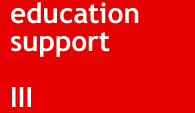

| CHCEDS305A | ||
|
Support the development of reading skills |
|
|
|
GlossaryA | B | C | D | E | F | G | H | I | J | K | L | M | N | O | P | Q | R | S | T | U V | W | X | Y | Z cohesive: ties all of the words used to make links between ideas in the text. For example, joining words such as and, but, however, after that, eventually; use of different words to refer to the same thing such as Mr. Smith, Joe, he, the boy's father culture: the way of life, especially the general behaviours, beliefs and attitudes of a particular social, ethnic or age group such as youth/working class culture decoding: the processes involved in changing written letters into spoken sounds to arrive at the meaning of the written text. Can be referred to as 'breaking the code'. discourse: can be thought of as an identity kit which comes complete with the appropriate costume and instructions on how to act, talk and write, so as to take on a particular role that others will recognize diversity: difference within and between groups and individuals resulting from the intersection of factors such as poverty, gender, disability, ethnicity, location, sexuality and culture encoding: the process of changing spoken language into the symbols of written language (writing), which is similar to converting spoken language into a code graphophonic code: the set of letters and sounds and the rules for using them to convert graphophonics: spoken language into written language. The 'grapho' part of the word is derived from the Greek rootgraphos meaning to write and the 'phonic' part is derived from the Greek root phonos meaning sound. intonation: the tone and the pitch of the voice when speaking language: language is made up of semiotic systems (written, oral, visual) that use sets of signs including words, sentences and paragraphs to convey meaning literacy: the flexible and sustainable mastery of a repertoire of practices with the texts of traditional and new communications technologies via spoken language, print, and multimedia, and the ability to use these practices in cultural and social contexts metalanguage: a language for talking about language, its patterns and conventions metalinguistic:
awareness of the form of language rather than its meanings i.e. morphemes: the smallest units of meaning in a word. For example, sighs (two morphemes sigh + the plural markers); size (one morpheme); pretty (one morpheme but two syllables). multiliteracies:
teachers use the term multiliteracies to focus on the ways
in which literacy education will continue to change in order to
equip students with the skills necessary to be active and informed
citizens in present and future societies, and to address the challenges
posed by a changing world onset-rime: the division of a single syllable word into the initial consonant or consonant blend (onset) and a unit containing a vowel sound and the final sound (rime). For example, p-ot (pot): str-ing (string): m-y (my) pedagogy: all of the various aspects associated with teaching including teaching, assessing and planning phonological:
awareness of the concepts about the way spoken words sound phonemes: the smallest element of sound that allows us to differentiate between words. For example, cat, rat or big, bag. The sounds represented by those letters are phonemes. Phonemes are the smallest building blocks of our language. phonemic:
awareness of the concepts about the structure of words (individual phonics: a term commonly used instead of the term graphophonics. The word makes reference to the 'sound' aspect of the word and does not include the 'letter' aspect. Phonics and graphophonics are used interchangeably. reading: a social practice that is always purposeful. Reading is also a problem-solving process that draws on a repertoire of social, cultural and cognitive resources for making meaning from traditional and multimodal texts. scaffold: in pedagogy, temporary support given to students to enable their progress toward independent thinking and learning. This support may take the form of explanations, examples, pictures or diagrams, with teacher modelling of procedures or responses. The amount of scaffolding is deliberately reduced as the student progresses. semantic
or semantics: the study of meaning in language semantic cueing: the meaning clues the reader is able to use to decode and to make system meaning. The clues relate to all of the different kinds of knowledge the reader has related to the reading. teacher talk: the term used to refer to the specific way teachers and support personnel use language to interact with students for the purpose of supporting their learning text: an all-encompassing term that relates to a coherent stretch of spoken, written, visual, auditory, gestural and spatial language produced in an interaction to exchange meaning in a social context syntax word order: the rules that govern the way the words are ordered in sentences syntactic
cueing: the clues the reader is able to use about possible words
because of system their knowledge of sentence and clause structure
as they decode and
|
||
|
|
|